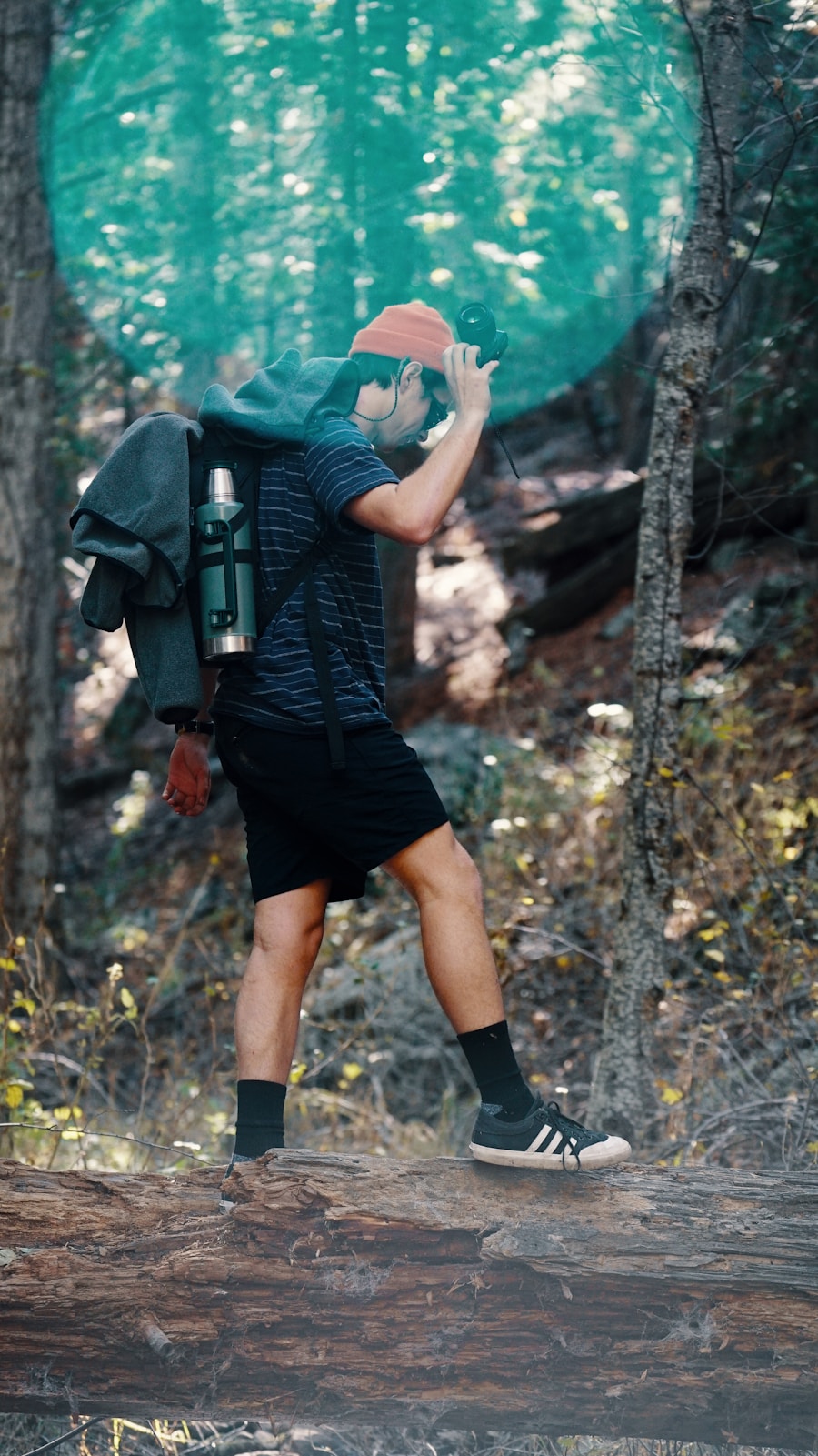Hiking in hot weather presents unique challenges that can significantly impact both comfort and safety. The right clothing is essential for regulating body temperature, preventing overheating, and ensuring that the hiker can enjoy the experience without succumbing to heat-related illnesses. When temperatures soar, the body works harder to maintain a stable internal temperature, which can lead to excessive sweating and dehydration.
Wearing appropriate clothing can mitigate these effects, allowing hikers to focus on the beauty of their surroundings rather than the discomfort of their attire. Moreover, proper clothing serves as a barrier against environmental elements such as sun exposure, insects, and abrasions from vegetation. Lightweight, moisture-wicking fabrics not only help in evaporating sweat but also provide a degree of protection from harmful UV rays.
This is particularly important in open areas where shade is scarce. Additionally, the right clothing can help prevent chafing and irritation caused by prolonged movement in hot conditions. Therefore, understanding the significance of proper clothing is crucial for anyone planning to hike in warm weather.
Key Takeaways
- Proper clothing is essential for hiking in hot weather to prevent heat-related illnesses and discomfort.
- Lightweight and breathable fabrics such as nylon, polyester, and merino wool are ideal for hot weather hiking to wick away sweat and keep you cool.
- Choosing the right footwear for hot weather hiking, such as breathable and quick-drying hiking shoes or sandals, is crucial for comfort and preventing blisters.
- Sun protection is important for hot weather hiking, including wearing a wide-brimmed hat, UV-protective sunglasses, and applying sunscreen regularly.
- Hydration packs and water-resistant gear are essential for hot weather hiking to stay hydrated and protect your belongings from sweat and moisture.
Lightweight and Breathable Fabrics for Hot Weather Hiking
When selecting clothing for hot weather hiking, lightweight and breathable fabrics are paramount. Materials such as polyester, nylon, and merino wool are excellent choices due to their moisture-wicking properties. These fabrics draw sweat away from the skin, allowing it to evaporate quickly, which helps regulate body temperature.
For instance, many outdoor brands offer shirts made from synthetic blends that are specifically designed for high-performance activities in warm climates. These shirts often feature mesh panels or ventilation zones that enhance airflow, further aiding in cooling. In addition to moisture management, the breathability of fabrics plays a critical role in comfort during hikes.
Fabrics that allow air to circulate help prevent the buildup of heat and moisture against the skin. For example, a lightweight long-sleeve shirt made from breathable fabric can provide sun protection while still keeping the wearer cool. Furthermore, many modern hiking garments come with built-in UV protection, which is an added benefit when spending extended periods outdoors under direct sunlight.
Choosing the right fabric can make a significant difference in how enjoyable a hike can be in hot weather.
Choosing the Right Footwear for Hot Weather Hiking

Footwear is another critical component of hiking attire, especially in hot weather. The right shoes can enhance comfort and performance while minimizing the risk of blisters and other foot-related issues. Breathable hiking shoes or sandals made from lightweight materials are ideal for warm conditions.
Look for options that feature mesh uppers to allow for maximum airflow, which helps keep feet cool and dry. Brands like Merrell and Salomon offer models specifically designed for hot weather that incorporate these features. Additionally, proper fit is essential when selecting footwear for hiking in hot weather.
Shoes that are too tight can cause discomfort and lead to blisters, while those that are too loose may result in instability on uneven terrain. It’s advisable to try on hiking shoes with the socks you plan to wear during your hike to ensure a proper fit. Furthermore, consider footwear with good traction and support; this is particularly important when navigating rocky or uneven trails.
Investing in quality footwear not only enhances comfort but also contributes to overall safety during hikes in hot conditions.
Sun Protection: Hats, Sunglasses, and Sunscreen
| Product | SPF | UV Protection | Water Resistant |
|---|---|---|---|
| Sunscreen | 30 | Broad Spectrum | Yes |
| Hats | N/A | UPF 50+ | No |
| Sunglasses | N/A | 100% UV Protection | No |
Sun protection is a vital consideration for hikers venturing out in hot weather. Prolonged exposure to UV rays can lead to sunburn, heat exhaustion, and long-term skin damage. A wide-brimmed hat is an excellent accessory for shielding the face and neck from direct sunlight.
Hats made from lightweight, breathable materials with moisture-wicking properties can enhance comfort while providing essential protection. Some hats even come with built-in UV protection ratings, offering an extra layer of defense against harmful rays. Sunglasses are equally important for protecting the eyes from UV radiation.
Look for sunglasses that offer 100% UV protection and have polarized lenses to reduce glare from reflective surfaces like water or rocks. This not only protects the eyes but also enhances visibility on bright days. Additionally, applying a broad-spectrum sunscreen with an SPF of at least 30 is crucial for protecting exposed skin.
It’s advisable to choose a water-resistant formula that can withstand sweat and moisture during physical activity. Regular reapplication every two hours or after swimming or sweating is essential to maintain effective sun protection throughout the hike.
Hydration Packs and Water-resistant Gear
Staying hydrated is one of the most critical aspects of hiking in hot weather. Dehydration can occur quickly when temperatures rise, making it essential to have a reliable hydration system in place. Hydration packs are an excellent choice for hikers as they allow for hands-free drinking while on the move.
These packs typically come with a built-in reservoir and a tube that enables easy access to water without having to stop frequently. Many hydration packs also feature additional pockets for storing essentials like snacks or small gear. In addition to hydration packs, water-resistant gear can be beneficial during hikes in hot weather, especially if there’s a chance of rain or unexpected weather changes.
Lightweight rain jackets made from breathable materials can provide protection without causing overheating. Look for jackets with ventilation features such as pit zips or mesh lining to enhance airflow while keeping moisture at bay. Being prepared with water-resistant gear ensures that hikers remain comfortable and dry, allowing them to focus on enjoying their adventure rather than worrying about sudden weather changes.
Layering for Hot Weather Hiking

While it may seem counterintuitive to layer clothing in hot weather, strategic layering can actually enhance comfort during hikes. The key is to choose lightweight layers that can be easily added or removed as temperatures fluctuate throughout the day. For instance, starting with a moisture-wicking base layer helps manage sweat effectively while providing insulation if temperatures drop unexpectedly during early morning or late afternoon hikes.
A lightweight long-sleeve shirt can serve as an excellent mid-layer for added sun protection without causing overheating. If conditions become too warm, this layer can be easily removed and stored in a backpack without taking up much space. Additionally, consider incorporating a lightweight outer layer that offers wind resistance or light rain protection without compromising breathability.
This approach allows hikers to adapt to changing conditions while maintaining comfort throughout their journey.
Accessories for Hot Weather Hiking: Bandanas, Cooling Towels, and More
Accessories play a significant role in enhancing comfort during hot weather hikes. Bandanas are versatile items that can be used in various ways; they can be worn around the neck to absorb sweat or tied around the head to keep hair off the face and provide additional sun protection. Soaking a bandana in cold water before wearing it can create a cooling effect that helps lower body temperature during strenuous activities.
Cooling towels are another excellent accessory for hot weather hiking. These towels are designed to retain moisture while remaining lightweight and portable. Simply wet the towel and wring it out before placing it around the neck or on pulse points like wrists or ankles for instant relief from heat.
Many hikers also find value in carrying portable fans or personal misting devices that provide additional cooling options during breaks on the trail.
Packing Essentials for Hot Weather Hiking
When preparing for a hike in hot weather, packing essentials thoughtfully is crucial for ensuring a safe and enjoyable experience. In addition to proper clothing and footwear, it’s important to include items such as extra water bottles or hydration reservoirs to ensure adequate hydration throughout the hike. Snacks high in electrolytes—such as trail mix with nuts and dried fruits—can help replenish lost minerals due to sweating.
First aid kits should also be part of any hiking pack; they should include items like blister pads, antiseptic wipes, and bandages tailored for outdoor activities. A compact emergency blanket can provide warmth if temperatures drop unexpectedly at night or during breaks. Additionally, consider packing a lightweight backpacking stove or portable cooking gear if planning on longer hikes where meals may be prepared on-site.
By carefully selecting what to pack based on anticipated conditions and personal needs, hikers can enhance their overall experience while minimizing risks associated with hot weather hiking.
If you’re planning a hiking trip in 80-degree weather, you may also be interested in reading about the best time to travel to Alaska in the summer or fall. Alaska offers stunning landscapes and outdoor activities, making it a popular destination for adventure seekers. Check out this article for tips on when to visit this beautiful state for your next outdoor adventure.
FAQs
What should I wear for hiking in 80 degree weather?
For hiking in 80 degree weather, it’s important to wear lightweight and breathable clothing to help keep you cool and comfortable. Opt for moisture-wicking fabrics that will help to keep sweat away from your skin.
What type of shirt is best for hiking in 80 degree weather?
A moisture-wicking, breathable, and lightweight shirt is best for hiking in 80 degree weather. Look for options made from synthetic materials or merino wool, as they are known for their moisture-wicking properties.
What kind of pants are suitable for hiking in 80 degree weather?
For hiking in 80 degree weather, consider wearing lightweight and quick-drying hiking pants or shorts. Look for options with built-in UV protection and breathable materials to keep you cool and protected from the sun.
What type of footwear is recommended for hiking in 80 degree weather?
For hiking in 80 degree weather, it’s best to wear breathable and lightweight hiking shoes or trail running shoes. Look for options with good ventilation and support to keep your feet comfortable on the trail.
What accessories should I consider for hiking in 80 degree weather?
Accessories such as a wide-brimmed hat, sunglasses, sunscreen, and a hydration pack or water bottle are essential for hiking in 80 degree weather. These items will help protect you from the sun and keep you hydrated throughout your hike.
